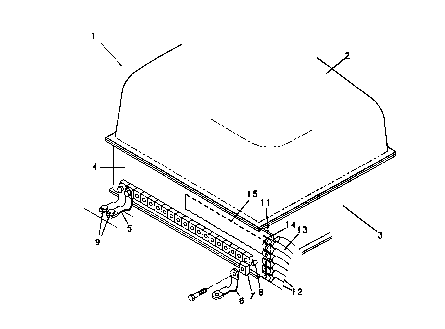Some of the information on this Web page has been provided by external sources. The Government of Canada is not responsible for the accuracy, reliability or currency of the information supplied by external sources. Users wishing to rely upon this information should consult directly with the source of the information. Content provided by external sources is not subject to official languages, privacy and accessibility requirements.
Any discrepancies in the text and image of the Claims and Abstract are due to differing posting times. Text of the Claims and Abstract are posted:
| (12) Patent: | (11) CA 2044056 |
|---|---|
| (54) English Title: | BONDED BUSBAR FOR DIAPHRAGM CELL CATHODE |
| (54) French Title: | BARRE OMNIBUS LIEE A L'INTERFACE POUR CATHODE DE CELLULE A DIAPHRAGME |
| Status: | Expired and beyond the Period of Reversal |
| (51) International Patent Classification (IPC): |
|
|---|---|
| (72) Inventors : |
|
| (73) Owners : |
|
| (71) Applicants : |
|
| (74) Agent: | GOWLING WLG (CANADA) LLP |
| (74) Associate agent: | |
| (45) Issued: | 2000-07-18 |
| (22) Filed Date: | 1991-06-06 |
| (41) Open to Public Inspection: | 1992-01-14 |
| Examination requested: | 1991-06-06 |
| Availability of licence: | N/A |
| Dedicated to the Public: | N/A |
| (25) Language of filing: | English |
| Patent Cooperation Treaty (PCT): | No |
|---|
| (30) Application Priority Data: | ||||||
|---|---|---|---|---|---|---|
|
In a sidewall-enclosed electrolytic cell, such as
for the electrolysis of brine to form chloralkali
product, the cell can have at least one cathode
sidewall. There is now provided an at least
substantially wall-sized, planar busbar that is
interface bonded to the cathode sidewall. The interface
bonded, wall-sized busbar plus sidewall thereby at least
substantially serve as a wall unit for the electrolytic
cell. The wall-sized busbar has at least one internal
passageway therethrough for the circulation of cooling
fluid. Where the bonded busbar is connected by a jumper
switch for current connection, the cooling passageway of
the busbar may connect at the location of the jumper
switch.
Note: Claims are shown in the official language in which they were submitted.
Note: Descriptions are shown in the official language in which they were submitted.

2024-08-01:As part of the Next Generation Patents (NGP) transition, the Canadian Patents Database (CPD) now contains a more detailed Event History, which replicates the Event Log of our new back-office solution.
Please note that "Inactive:" events refers to events no longer in use in our new back-office solution.
For a clearer understanding of the status of the application/patent presented on this page, the site Disclaimer , as well as the definitions for Patent , Event History , Maintenance Fee and Payment History should be consulted.
| Description | Date |
|---|---|
| Time Limit for Reversal Expired | 2009-06-08 |
| Letter Sent | 2008-06-06 |
| Letter Sent | 2005-11-23 |
| Letter Sent | 2005-01-24 |
| Inactive: Office letter | 2004-05-11 |
| Inactive: Multiple transfers | 2004-04-21 |
| Inactive: Office letter | 2003-07-22 |
| Grant by Issuance | 2000-07-18 |
| Inactive: Cover page published | 2000-07-17 |
| Letter Sent | 2000-05-08 |
| Letter Sent | 2000-05-08 |
| Pre-grant | 2000-04-07 |
| Inactive: Final fee received | 2000-04-07 |
| Inactive: Single transfer | 2000-04-07 |
| Notice of Allowance is Issued | 1999-11-12 |
| Letter Sent | 1999-11-12 |
| Notice of Allowance is Issued | 1999-11-12 |
| Inactive: Status info is complete as of Log entry date | 1999-11-05 |
| Inactive: Application prosecuted on TS as of Log entry date | 1999-11-05 |
| Inactive: Approved for allowance (AFA) | 1999-10-26 |
| Application Published (Open to Public Inspection) | 1992-01-14 |
| Request for Examination Requirements Determined Compliant | 1991-06-06 |
| All Requirements for Examination Determined Compliant | 1991-06-06 |
There is no abandonment history.
The last payment was received on 2000-03-15
Note : If the full payment has not been received on or before the date indicated, a further fee may be required which may be one of the following
Patent fees are adjusted on the 1st of January every year. The amounts above are the current amounts if received by December 31 of the current year.
Please refer to the CIPO
Patent Fees
web page to see all current fee amounts.
| Fee Type | Anniversary Year | Due Date | Paid Date |
|---|---|---|---|
| MF (application, 7th anniv.) - standard | 07 | 1998-06-08 | 1998-03-24 |
| MF (application, 8th anniv.) - standard | 08 | 1999-06-07 | 1999-02-16 |
| MF (application, 9th anniv.) - standard | 09 | 2000-06-06 | 2000-03-15 |
| Final fee - standard | 2000-04-07 | ||
| Registration of a document | 2000-04-07 | ||
| MF (patent, 10th anniv.) - standard | 2001-06-06 | 2001-04-04 | |
| MF (patent, 11th anniv.) - standard | 2002-06-06 | 2002-05-02 | |
| MF (patent, 12th anniv.) - standard | 2003-06-06 | 2003-05-02 | |
| Registration of a document | 2003-05-27 | ||
| MF (patent, 13th anniv.) - standard | 2004-06-07 | 2004-05-06 | |
| MF (patent, 14th anniv.) - standard | 2005-06-06 | 2005-05-09 | |
| Registration of a document | 2005-09-09 | ||
| MF (patent, 15th anniv.) - standard | 2006-06-06 | 2006-05-08 | |
| MF (patent, 16th anniv.) - standard | 2007-06-06 | 2007-05-07 |
Note: Records showing the ownership history in alphabetical order.
| Current Owners on Record |
|---|
| ELTECH SYSTEMS CORPORATION |
| Past Owners on Record |
|---|
| JAMES W. PYLE |
| L. CALVERT CURLIN |
| RICHARD L. ROMINE |
| ROBERT B. KUBINSKI |